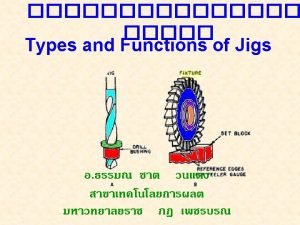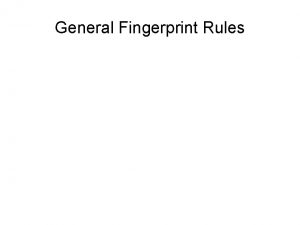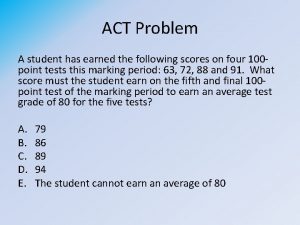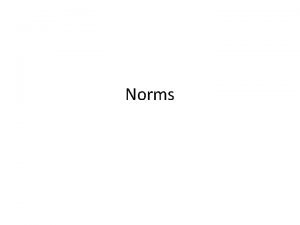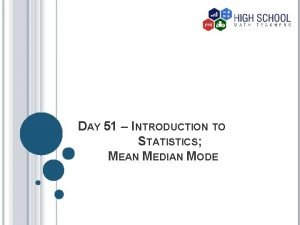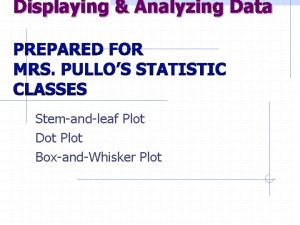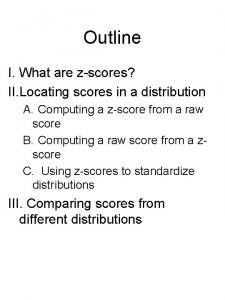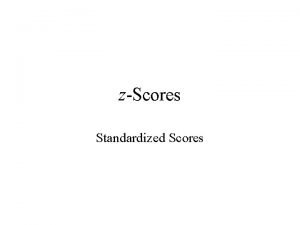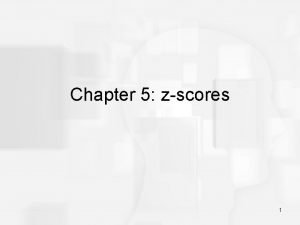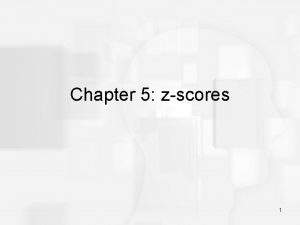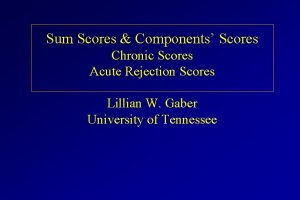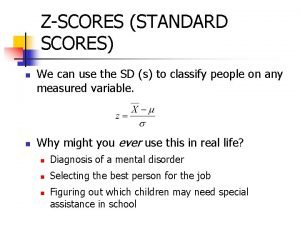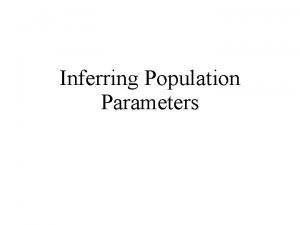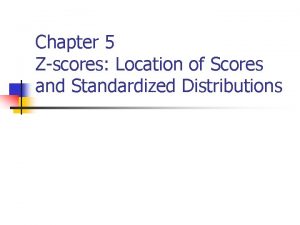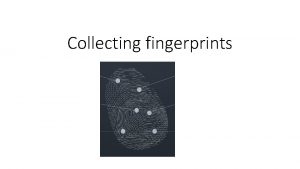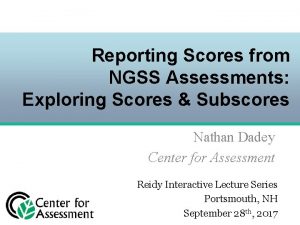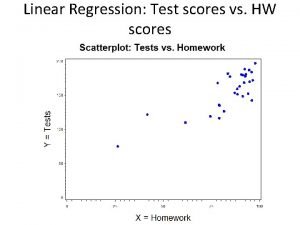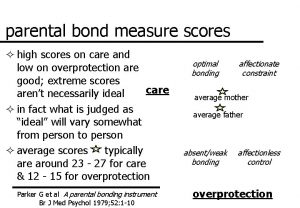Outline I What are zscores II Locating scores












































- Slides: 44

Outline I. What are z-scores? II. Locating scores in a distribution A. Computing a z-score from a raw score B. Computing a raw score from a zscore C. Using z-scores to standardize distributions III. Comparing scores from different distributions

I. What are z scores? You scored 76 How well did you perform? serves as reference point: Are you above or below average? serves as yardstick: How much are you above or below? • • • Convert raw score to a z-score describes a score relative to & Two useful purposes: Tell exact location of score in a distribution Compare scores across different distributions

II. Locating Scores in a distribution Deviation from in SD units Relative status, location, of a raw score (X) z-score has 2 parts: 1. Sign tells you above (+) or below (-) 2. Value tells magnitude of distance in SD units

A. Converting a raw score (X) to a z-score: Example: Spelling bee: = 8 Garth X=6 Peggy X=11 =2 z= z=

B. Converting a z-score to a raw score: Example: Spelling bee: = 8 Hellen z =. 5 Andy z = 0 =2 X= X= raw score = mean + deviation

C. Using z-scores to Standardize a Distribution Convert each raw score to a z-score What is the shape of the new dist’n? Same as it was before! Does NOT alter shape of dist’n! Re-labeling values, but order stays the same! What is the mean? =0 Convenient reference point! What is the standard deviation? =1 z always tells you # of SD units from !

An entire population of scores is transformed into z-scores. The transformation does not change the shape of the population but the mean is transformed into a value of 0 and the standard deviation is transformed to a value of 1.

Example: Student X Garth 6 Peggy 11 Andy 8 Hellen 9 Humphry 5 Vivian 9 X- z N=6 =8 = 0 =2 =1 So, a distribution of z-scores always has: =0 =1 A standardized distribution helps us compare scores from different distributions

III. Comparing Scores From Different Dist’s Example: Jim in class A scored 18 Mary in class B scored 75 Who performed better? Need a “common metric” Express each score relative to it’s own & Transform raw scores to z-scores Standardize the distributions they will now have same &

Example: Class A: Jim scored 18 = 10 =5 Class B: Mary scored 75 = 50 = 25 Who performed better? Jim! Two z-scores can always be compared

Outline: Probability and The Normal Curve I. Probability A. Probability and inferential statistics B. What is probability? II. The Normal Curve A. Probability and the Normal Curve B. Properties of the Standard Normal Curve C. The Unit Normal Table III. Solving Problems with the Normal Curve A. Problem Type 1 B. Problem Type 2 C. Cautions

I. Probability A. Probability & Inferential Statistics Transition to inferential statistics Why is probability so important? Links samples and populations Example 1: The jar is a “population” One marble is a “sample” How likely to get BLACK? But, isn’t the goal of inferential stats the opposite? Example 2: Choose 10 marbles, blindfolded “Sample” has 8 BLACK & 2 WHITE Which jar did marbles come from? This is inferential statistics! “Judgments under uncertainty”

B. What is probability? Likelihood of an “event” occurring Can range from 0 (never) to 1. 0 (always) Defined in terms of a fraction, proportion, or percentage p(A) = Number of outcomes classified as A Total number of possible outcomes Example #1: Toss a coin, what is probability of heads? p(Heads) = 1/2 1 = one way to get heads 2 = two possible outcomes (heads or tails) ½ = . 50 = 50%

Example #2: Select a card from a deck of 52 cards What is probability of selecting a king? p(King) = 4/52 4 = four ways to get a king 52 = 52 possible outcomes 4/52 = . 077 = 7. 7%

Compute probability from a frequency distribution X f 9 1 8 3 7 4 6 2 Σf = N = 10 What is the probability of selecting a score with x = 8? p(x = 8) = f/N = 3/10 =. 30 = 30% What is the probability of selecting a score with x < 8? p(x < 8) = f/N = 6/10 =. 60 = 60%

II. The Normal Curve A. Probability and the Normal Curve – Special statistical tool called the Normal Curve – Theoretical curve defined by mathematical formula – Known proportions/areas under the curve – Used to solve problems when we don’t know the population

B. Properties of the Standard Normal Curve • Theoretical, idealized curve • Based on mathematical formula • Bell-shaped, symmetrical, unimodal • μ = Md = Mo • 50% of scores above m, 50% below • Standardized: μ = 0, σ = 1 • A probability distribution, tails not anchored to axis • Total area under the curve will sum to 1. 0 • Exact percentiles associated with each z-score • Area under curve provided in Unit Normal Table • Can be applied to any normal distribution once the distribution is standardized (converted to z-scores)

Why is the normal curve so important? (1) Many variables normally distributed in population (2) Can use normal curve to solve many problems Two types of problems: (1) What proportion of dist’n falls above, below, or between particular z-scores? (2) What z-score is associated with particular proportions/probabilities under the curve?

C. The Unit Normal Table (UNT) A = z-scores B = Proportion in body (larger portion) C = Proportion in tail (smaller portion) • Curve is symmetrical, only + z scores shown • Columns B & C always sum to 1. 0 • Proportions/probabilities are always positive


z-score cuts curve into two portions (B & C)

Let’s Practice! Tip: Always sketch a curve first! Examples 1: What proportion of distribution falls above z = 1. 5? p (z > 1. 5) What proportion falls below z = -. 5? p (z < -0. 5)

Examples 2: What z-score separates the lower 75% from the upper 25%? (same as 75 th percentile) What z-scores separate the middle 60% of the distribution from the rest of the distribution?

II. Solving Problems with the Normal Curve Hints and Tips Two types of problems: (1) Finding proportion associated with X or z (2) Finding X or z associated with proportion Problem Type #1 Steps to Follow: (a) Sketch curve (b) Convert raw score to z-score (c) Look up proportion for this z-score (d) Sometimes add/subtract proportions Problem type #2 Steps to Follow: (a) Sketch curve (b) Look up z-score associated with proportion (c) Convert z-score back to a raw score (X) Always sketch a normal curve first!

A. Problem Type 1: Finding Area Under the Curve Problem #1: Exam: μ = 60 σ = 10 What percentage will score below 70? (1) Sketch a normal curve (2) Convert raw score to z-score z= (3) Plan your strategy (4) Refer to Unit Normal Table

Problem #2: Exam μ = 60 σ = 10 What is percentile rank of student who scored 55? (1) Sketch a normal curve (2) (3) Convert raw score to z-score z= Plan your strategy (4) Refer to UNT

Problem #3: Exam μ = 60 σ = 10 What proportion of people will score between 60 and 80? (1) Sketch a normal curve (2) Convert raw score to z-score z= (3) Plan your strategy (4) Refer to UNT

Problem #4: Exam: μ = 60 σ = 10 What proportion of people will score between 50 and 80? (1) Sketch a normal curve (2) Convert raw scores to zscores z 1 = z 2 = (3) Plan your strategy (4) Refer to UNT

B. Problem Type 2: Finding a Score Associated with a Proportion or Percentile Problem #5: Standardized Exam: μ = 60 σ = 10 Assign A+ to the 95 th percentile What is cut-off score for earning an A+? (1) Sketch curve (2) Plan your solution (3) Refer to UNT z= (4) Convert z-score back to raw score: x= +zσ x=

Problem #6: Exam: μ = 60 σ = 10 Assign F to 15 th percentile (and below) What is cut-off score for earning an F? (1) Sketch curve (2) Plan your solution (3) Refer to UNT z= (4) Convert z-score back to raw score: x= +zσ x=

C. Cautions In order to use the UNT to solve problems, you must: • have known μ and σ • assume your variable is normally distributed Why? • If you don’t know μ & σ, can’t compute a zscore • If variable is not normally distributed, percentages given by UNT won’t apply! • z-scores can be negative but proportions/ percentiles cannot! • Pay close attention to the words… – Above, Below, Within, Beyond

The Distribution of Sample Means Inferential statistics: Generalize from a sample to a population Statistics vs. Parameters Why? Population not often possible Limitation: Sample won’t precisely reflect population Samples from same population vary “sampling variability” Sampling error = discrepancy between sample statistic and population parameter

The Distribution of Sample Means • Extend z-scores and normal curve to SAMPLE MEANS rather than individual scores • How well will a sample describe a population? • What is probability of selecting a sample that has a certain mean? • Sample size will be critical – Larger samples are more representative – Larger samples = smaller error

The Distribution of Sample Means Population of 4 scores: 2 4 6 8 =5 4 random samples (n = 2): is rarely exactly Most a little bigger or smaller than Most will cluster around Extreme low or high values of are relatively rare With larger n, s will cluster closer to µ (the DSM will have smaller error, smaller variance) We don’t actually compute a DSM!

A Distribution of Sample Means X=4 X=5 X=6 The distribution of sample means for n = 2. This distribution shows the 16 sample means obtained by taking all possible random samples of size n=2 that can be drawn from the population of 4 scores. The known population mean from which these samples were drawn is µ = 5.

The Distribution of Sample Means A distribution of sample means ( ) All possible random samples of size n A distribution of a statistic (not raw scores) “Sampling Distribution” of Probability of getting an , given known and Important properties (1) Mean (2) Standard Deviation (3) Shape

Properties of the DSM Mean? Called expected value of Standard Deviation? Any can be viewed as a deviation from = Standard Error of the Mean Variability of around Special type of standard deviation, type of “error” Average amount by which deviates from

Less error = better, more reliable, estimate of population parameter influenced by two things: (1) Sample size (n) Larger n = smaller standard errors Note: when n = 1 as “starting point” for gets smaller as n increases (2) Variability in population ( ) Larger = larger standard errors Note:

The distribution of sample means for random samples of size (a) n = 1, (b) n = 4, and (c) n = 100 obtained from a normal population with µ = 80 and σ = 20. Notice that the size of the standard error decreases as the sample size increases.

Shape of the DSM? Central Limit Theorem = DSM will approach a normal dist’n as n approaches infinity Very important! True even when raw scores NOT normal! True regardless of or What about sample size? (1) If raw scores ARE normal, any n will do (2)If raw scores NOT normal, n must be “sufficiently large” For most distributions n 30

Why are Sampling Distributions important? • Tells us probability of getting , given & • Distribution of a STATISTIC rather than raw scores • Theoretical probability distribution • Critical for inferential statistics! • Allows us to estimate likelihood of making an error when generalizing from sample to popl’n • Standard error = variability due to chance • Allows us to estimate population parameters • Allows us to compare differences between sample means – due to chance or to experimental treatment? • Sampling distribution is the most fundamental concept underlying all statistical tests

Working with the Distribution of Sample Means • If we assume DSM is normal • If we know & • We can use Normal Curve & Unit Normal Table! Example #1: = 80 = 12 What is probability of getting if n = 9? 86

Example #1 b: = 80 = 12 What if we change n =36 What is probability of getting 86

Example #2: = 80 = 12 What marks the point beyond which sample means are likely to occur only 5% of the time? (n = 9)
 Mikael ferm
Mikael ferm Zscorelive
Zscorelive Typologies are nominal composite measures
Typologies are nominal composite measures Recruitment is the process of locating identifying and
Recruitment is the process of locating identifying and Close packing
Close packing Conductive locating
Conductive locating Champion cooling company is locating a warehouse
Champion cooling company is locating a warehouse Angle plate jig diagram
Angle plate jig diagram Locating ordered pairs on the coordinate plane
Locating ordered pairs on the coordinate plane Locating the main idea
Locating the main idea Earth science regents lab practical
Earth science regents lab practical Triangulation method in earthquake
Triangulation method in earthquake Locating places
Locating places Four ways of locating the ethical in you
Four ways of locating the ethical in you Smart city locating
Smart city locating What are the rules in the selection of delta
What are the rules in the selection of delta Sandwich paragraph example
Sandwich paragraph example A student has earned the following scores
A student has earned the following scores Lexile range chart
Lexile range chart Rias iq test
Rias iq test Interpreting test scores and norms
Interpreting test scores and norms High psat scores
High psat scores Webreg uci schedule of classes
Webreg uci schedule of classes Key stage 1 scaled scores
Key stage 1 scaled scores Ielts meaning
Ielts meaning Nonverbal index wisc v
Nonverbal index wisc v Celf scores interpreteren
Celf scores interpreteren Apgar scoring system
Apgar scoring system Danielson teacher evaluation scores
Danielson teacher evaluation scores Iready diagnostic scores
Iready diagnostic scores Osteoporosis t scores
Osteoporosis t scores Itbs scores
Itbs scores Pact scores
Pact scores Aimsweb percentile chart
Aimsweb percentile chart Libero tracking example
Libero tracking example Median and mode
Median and mode Norm referenced and criterion referenced
Norm referenced and criterion referenced Brigance data sheets
Brigance data sheets Fldoe vam scores by teacher
Fldoe vam scores by teacher Sol scaled score chart
Sol scaled score chart Star enterprise scaled scores
Star enterprise scaled scores Summary sheet of iqms scores
Summary sheet of iqms scores Sdsu wpa
Sdsu wpa Aimsweb percentile chart 2021
Aimsweb percentile chart 2021 Dot
Dot







